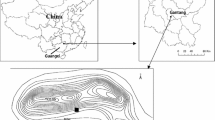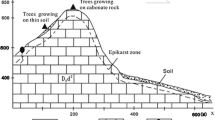Abstract
It is not clear how the water sources are used by trees in typical karst areas of Guangxi, China. Trees growing on rigid carbonate rock can primarily use spring water, precipitation-recharged soil water or a mixture of the two. In this study, the Nongla karst dynamic monitoring station in the southwest of Guangxi, China, was observed. To determine the water sources accessed by trees growing on rigid carbonate rock, seasonal change of isotope ratios (δ18O and δ D) in twig sap, soil water, rainfall and spring water were measured. Stem water samples plotted to the right of the meteoric water line indicates utilization of water sources subject to evaporative isotopic enrichment. Trees growing on rigid carbonate rock in the southwest of China used rainfall directly in the rainy season. Adult trees tended to use deeper water stored in the epikarst zone, while the young ones used soil water when precipitation decreased. In the dry season, all trees sampled depend mostly on water stored in the epikarst zone. Spring water was the major water source for all of the tree species investigated in the dry season. In conclusion, these data indicate that trees growing on rigid carbonate rock in southwest China depend mostly on water stored in the epikarst zone. Therefore, water storage in the epikarst zone is the essential water source for trees growing on carbonate rock in southwest China.



Similar content being viewed by others
References
Borchert R, Meyer SA, Felger RS, Porter-Bolland L (2004) Environmental control of Xowering periodicity in Costa Rican and Mexican tropical dry forests. Global Ecol Biogeogr 13:409–425
Cao J, Yuan D, Pan G (2003) Some soil features in karst ecosystem. Adv Earth Sci 18(1):37–44 (in Chinese with English abstract)
Chapotin SM, Razanameharizaka JH, Holbrook NM (2006) Baobab trees (Adansonia) in Madagascar use stored water to flush new leaves but not to support stomatal opening before the rainy season. New Phytol 169:549–559
Chimner RA, Cooper DJ (2004) Using stable oxygen isotopes to quantify the water source used for transpiration by native shrubs in the San Luis Valley. Colorado USA Plant Soil 260:225–236
Dawson TE, Ehleringer JR (1991) Streamside trees that do not use stream water. Nature 350(28):335–337
Ehleringer JR, Dawson TE (1992) Water uptake by plants: perspectives from stable isotope composition. Plant Cell Environ 15:1073–1082
Ewe SML, Sternberg L, Busch DE (1999) Water use patterns of woody species in pineland and hammock communities of South Florida. For Ecol Manage 118:139–148
Farrington P, Turner JV, Gailitis V (1996) Tracing water uptake by Jarrah (Eucalyptus marginata) trees using natural abundances of deuterium. Trees 11:9–15
Flanagan LB, Ehleringer JR, Marshall JD (1992) Differential uptake of summer precipitation among co-occurring trees and shrubs in a pinyon-juniper woodland. Plant Cell Environ 15:831–836
Jackson PC, Cavelier J, Goldstein G, Meinzer FC, Holbrook NM (1995) Partitioning of water resources among plants of a lowland tropical forest. Oecologia 101:197–203
Jackson PC, Meinzer FC, Bustamante M, Goldstein G, Franco A, Rundel PW, Caldas L, Igler E, Causin F (1999) Partitioning of soil water among tree species in a Brazilian Cerrado ecosystem. Tree Physiol 19:717–724
Jiang Z, Yuan D (1999) Dynamics features of the epikarst zone and their significance in environments and resources. Acta Geoscientia Sinica 20(3):302–308 (in Chinese with English abstract)
Li B, Yuan D, Lin Y, Qin J, Zhang M (2000) Oxygen and carbon isotopic characteristics of rainwater, drip water and present speleothems in a cave in Guilin areas, and their environmental meanings. Sci China 43(3):277–285
Li X, He Ch, Jiang Z (2003) Method and principles of ecological rehabilitation and reconstruction in fragile karst ecosystem. Carsologica Sinica 22(1):12–17 (in Chinese with English abstract)
Li S, Romero-Saltos H, Tsujimura M, Sugimoto A, Sasaki L, Davaa G, Oyunbaatar D (2007) Plant water sources in the cold semiarid ecosystem of the upper Kherlen River catchment in Mongolia: a stable isotope approach. J Hydrol 333:109–117
Li Q, Sun H, Han J, Liu Z, Yu L (2008) High-resolution study on the hydrochemical variations caused by the dilution of precipitation in the epikarst spring: an example spring of Landiantang at Nongla, Mashan, China. Environ Geol 54:347–354
Lin Zh (2004) Ecoeconomics improving model of stone desertification in Guangxi karst region. J of Guangxi Teachers Education University (Natural science edition) 21(2):34–37 (in Chinese with English abstract)
Meinzer FC, Andrade JL, Goldstein G, Holbrook NM, Cavelier J, Wright SJ (1999) Partitioning of soil water among canopy trees in a seasonally dry tropical forest. Oecologia 121:293–301
Querejeta JI, Estrada-Medina H, Allen MF, Jiménez-Osornio JJ (2007) Water source partitioning among trees growing on shallow karst soils in a seasonally dry tropical climate. Oecologia 152:26–36
Rose KL, Graham RC, Parker DR (2003) Water source utilization by Pinus Jeffreyi and Arctostaphylos patula on thin soils over bedrock. Oecologia 134:46–54
Schenk HJ, Jackson RB (2002) The global biogeography of roots. Ecol Monogr 72:311–328
Snyder KA, Williams DG (2000) Water sources used by riparian trees varies among stream types on the San Pedro River, Arizona. Agric For Meteorol 105:227–240
Stratton LC, Goldstein G, Meinzer FC (2000) Temporal and spatial partitioning of water resources among eight woody species in a Hawaiian dry forest. Oecologia 124:309–317
Thorburn PJ, Walker GR, Brunel JP (1993) Extraction of water from Eucalyptus trees for analysis of deuterium and oxygen-18: laboratory and field techniques. Plant Cell Environ 16:269–277
White JWC, Cook ER, Lawrence JR, Broecker WS (1985) The D/H ratios of sap in tress: implications for water sources and tree ring D/H ratios. Geochim Cosmochim Acta 49:237–246
Yuan D, Zhu D, Weng J et al (1991) Karst of china. Geological Publishing House, Beijing, p 1
Zencich SJ, Froend RH, Turner JV, Gailitis V (2002) Influence of groundwater depth on the seasonal sources of water accessed by Banksia tree species on a shallow, sandy coastal aquifer. Oecologia 131:8–19
Acknowledgments
This work was funded by the National Natural Science Foundation of China (No: 40902074), National Key Project of Science and Technical Supporting Programs (No: 2006BAC01A10) and supported by the Institute of Karst Geology (No: 2009009). The authors thank Qi Xiaofan and Wu Huaying for their assistance in the field.
Author information
Authors and Affiliations
Corresponding author
Rights and permissions
About this article
Cite this article
Deng, Y., Jiang, Z. & Qin, X. Water source partitioning among trees growing on carbonate rock in a subtropical region of Guangxi, China. Environ Earth Sci 66, 635–640 (2012). https://doi.org/10.1007/s12665-011-1272-9
Received:
Accepted:
Published:
Issue Date:
DOI: https://doi.org/10.1007/s12665-011-1272-9




